2007 CHEVROLET CORVETTE heater
[x] Cancel search: heaterPage 69 of 488
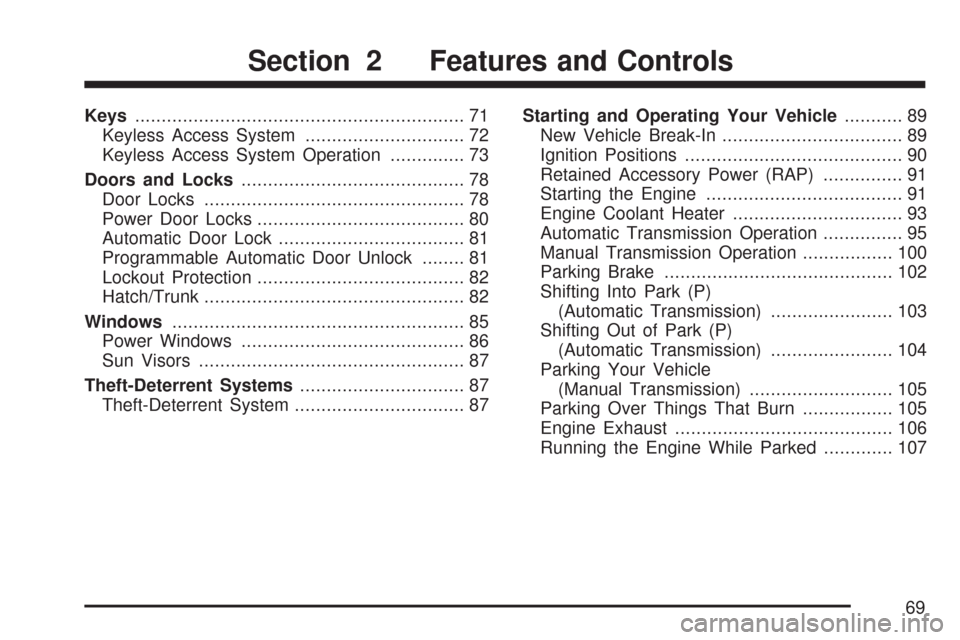
Keys.............................................................. 71
Keyless Access System.............................. 72
Keyless Access System Operation.............. 73
Doors and Locks.......................................... 78
Door Locks................................................. 78
Power Door Locks....................................... 80
Automatic Door Lock................................... 81
Programmable Automatic Door Unlock........ 81
Lockout Protection....................................... 82
Hatch/Trunk................................................. 82
Windows....................................................... 85
Power Windows.......................................... 86
Sun Visors.................................................. 87
Theft-Deterrent Systems............................... 87
Theft-Deterrent System................................ 87Starting and Operating Your Vehicle........... 89
New Vehicle Break-In.................................. 89
Ignition Positions......................................... 90
Retained Accessory Power (RAP)............... 91
Starting the Engine..................................... 91
Engine Coolant Heater................................ 93
Automatic Transmission Operation............... 95
Manual Transmission Operation................. 100
Parking Brake........................................... 102
Shifting Into Park (P)
(Automatic Transmission)....................... 103
Shifting Out of Park (P)
(Automatic Transmission)....................... 104
Parking Your Vehicle
(Manual Transmission)........................... 105
Parking Over Things That Burn................. 105
Engine Exhaust......................................... 106
Running the Engine While Parked............. 107
Section 2 Features and Controls
69
Page 93 of 488
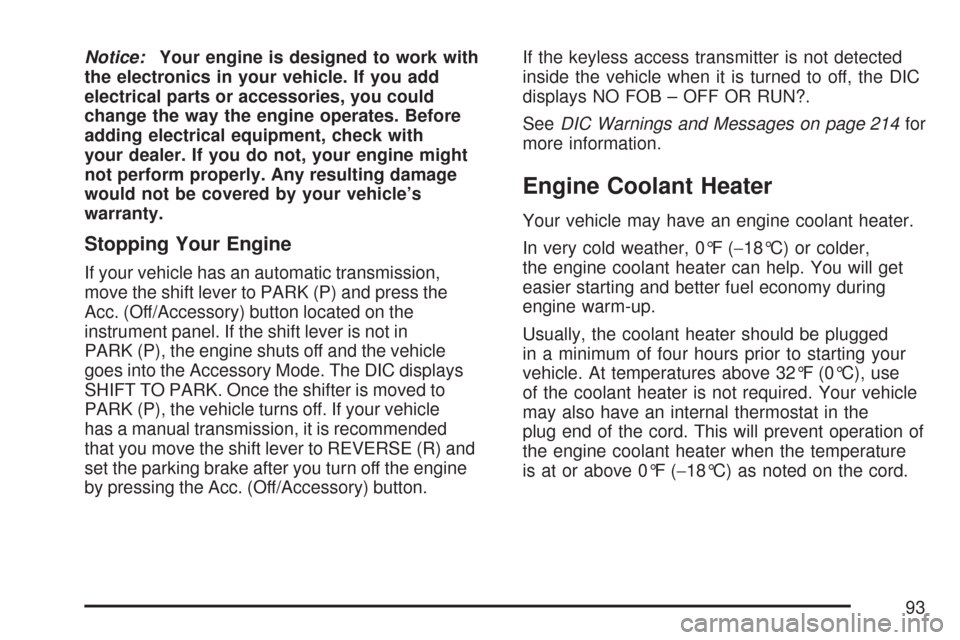
Notice:Your engine is designed to work with
the electronics in your vehicle. If you add
electrical parts or accessories, you could
change the way the engine operates. Before
adding electrical equipment, check with
your dealer. If you do not, your engine might
not perform properly. Any resulting damage
would not be covered by your vehicle’s
warranty.
Stopping Your Engine
If your vehicle has an automatic transmission,
move the shift lever to PARK (P) and press the
Acc. (Off/Accessory) button located on the
instrument panel. If the shift lever is not in
PARK (P), the engine shuts off and the vehicle
goes into the Accessory Mode. The DIC displays
SHIFT TO PARK. Once the shifter is moved to
PARK (P), the vehicle turns off. If your vehicle
has a manual transmission, it is recommended
that you move the shift lever to REVERSE (R) and
set the parking brake after you turn off the engine
by pressing the Acc. (Off/Accessory) button.If the keyless access transmitter is not detected
inside the vehicle when it is turned to off, the DIC
displays NO FOB – OFF OR RUN?.
SeeDIC Warnings and Messages on page 214for
more information.
Engine Coolant Heater
Your vehicle may have an engine coolant heater.
In very cold weather, 0°F (−18°C) or colder,
the engine coolant heater can help. You will get
easier starting and better fuel economy during
engine warm-up.
Usually, the coolant heater should be plugged
in a minimum of four hours prior to starting your
vehicle. At temperatures above 32°F (0°C), use
of the coolant heater is not required. Your vehicle
may also have an internal thermostat in the
plug end of the cord. This will prevent operation of
the engine coolant heater when the temperature
is at or above 0°F (−18°C) as noted on the cord.
93
Page 94 of 488
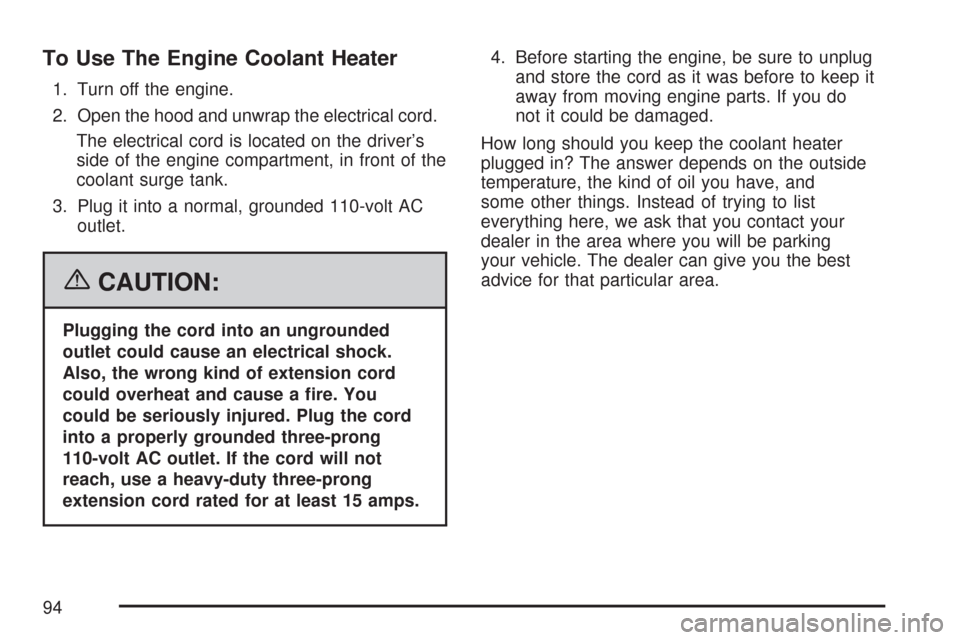
To Use The Engine Coolant Heater
1. Turn off the engine.
2. Open the hood and unwrap the electrical cord.
The electrical cord is located on the driver’s
side of the engine compartment, in front of the
coolant surge tank.
3. Plug it into a normal, grounded 110-volt AC
outlet.
{CAUTION:
Plugging the cord into an ungrounded
outlet could cause an electrical shock.
Also, the wrong kind of extension cord
could overheat and cause a �re. You
could be seriously injured. Plug the cord
into a properly grounded three-prong
110-volt AC outlet. If the cord will not
reach, use a heavy-duty three-prong
extension cord rated for at least 15 amps.4. Before starting the engine, be sure to unplug
and store the cord as it was before to keep it
away from moving engine parts. If you do
not it could be damaged.
How long should you keep the coolant heater
plugged in? The answer depends on the outside
temperature, the kind of oil you have, and
some other things. Instead of trying to list
everything here, we ask that you contact your
dealer in the area where you will be parking
your vehicle. The dealer can give you the best
advice for that particular area.
94
Page 308 of 488
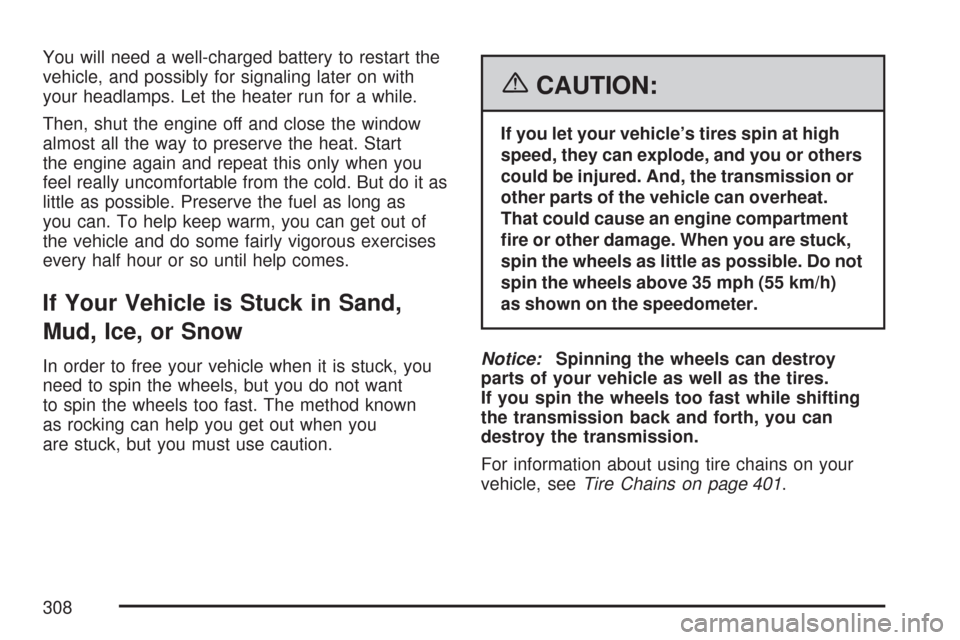
You will need a well-charged battery to restart the
vehicle, and possibly for signaling later on with
your headlamps. Let the heater run for a while.
Then, shut the engine off and close the window
almost all the way to preserve the heat. Start
the engine again and repeat this only when you
feel really uncomfortable from the cold. But do it as
little as possible. Preserve the fuel as long as
you can. To help keep warm, you can get out of
the vehicle and do some fairly vigorous exercises
every half hour or so until help comes.
If Your Vehicle is Stuck in Sand,
Mud, Ice, or Snow
In order to free your vehicle when it is stuck, you
need to spin the wheels, but you do not want
to spin the wheels too fast. The method known
as rocking can help you get out when you
are stuck, but you must use caution.
{CAUTION:
If you let your vehicle’s tires spin at high
speed, they can explode, and you or others
could be injured. And, the transmission or
other parts of the vehicle can overheat.
That could cause an engine compartment
�re or other damage. When you are stuck,
spin the wheels as little as possible. Do not
spin the wheels above 35 mph (55 km/h)
as shown on the speedometer.
Notice:Spinning the wheels can destroy
parts of your vehicle as well as the tires.
If you spin the wheels too fast while shifting
the transmission back and forth, you can
destroy the transmission.
For information about using tire chains on your
vehicle, seeTire Chains on page 401.
308
Page 347 of 488
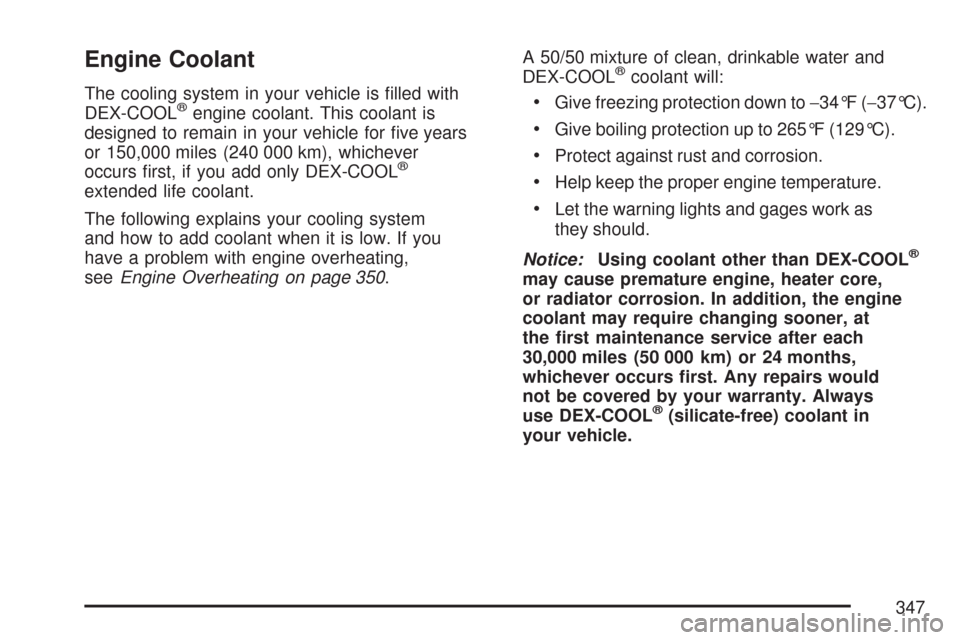
Engine Coolant
The cooling system in your vehicle is �lled with
DEX-COOL®engine coolant. This coolant is
designed to remain in your vehicle for �ve years
or 150,000 miles (240 000 km), whichever
occurs �rst, if you add only DEX-COOL
®
extended life coolant.
The following explains your cooling system
and how to add coolant when it is low. If you
have a problem with engine overheating,
seeEngine Overheating on page 350.A 50/50 mixture of clean, drinkable water and
DEX-COOL
®coolant will:
Give freezing protection down to−34°F (−37°C).
Give boiling protection up to 265°F (129°C).
Protect against rust and corrosion.
Help keep the proper engine temperature.
Let the warning lights and gages work as
they should.
Notice:Using coolant other than DEX-COOL
®
may cause premature engine, heater core,
or radiator corrosion. In addition, the engine
coolant may require changing sooner, at
the �rst maintenance service after each
30,000 miles (50 000 km) or 24 months,
whichever occurs �rst. Any repairs would
not be covered by your warranty. Always
use DEX-COOL
®(silicate-free) coolant in
your vehicle.
347
Page 348 of 488
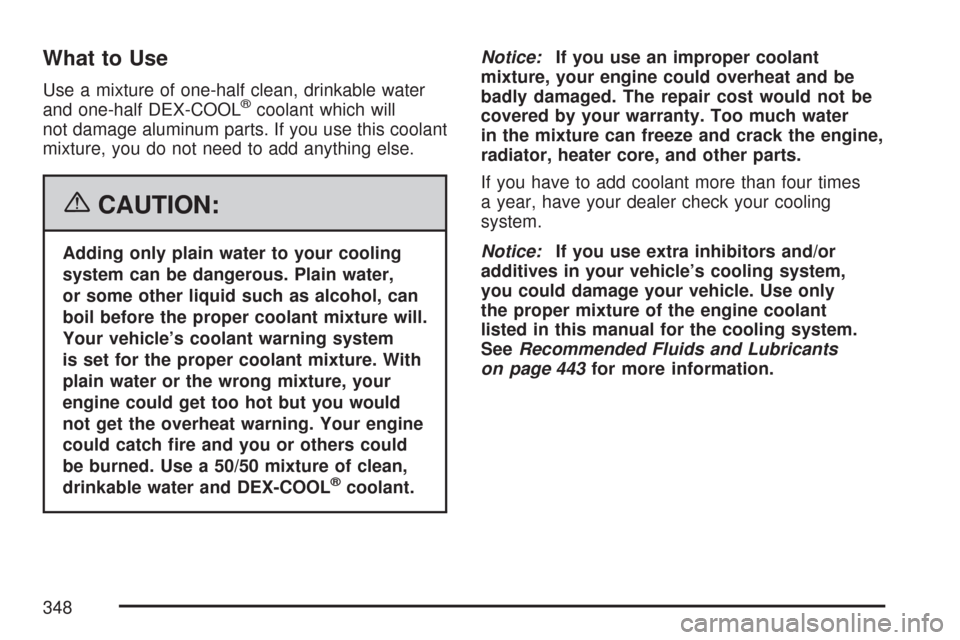
What to Use
Use a mixture of one-half clean, drinkable water
and one-half DEX-COOL®coolant which will
not damage aluminum parts. If you use this coolant
mixture, you do not need to add anything else.
{CAUTION:
Adding only plain water to your cooling
system can be dangerous. Plain water,
or some other liquid such as alcohol, can
boil before the proper coolant mixture will.
Your vehicle’s coolant warning system
is set for the proper coolant mixture. With
plain water or the wrong mixture, your
engine could get too hot but you would
not get the overheat warning. Your engine
could catch �re and you or others could
be burned. Use a 50/50 mixture of clean,
drinkable water and DEX-COOL
®coolant.Notice:If you use an improper coolant
mixture, your engine could overheat and be
badly damaged. The repair cost would not be
covered by your warranty. Too much water
in the mixture can freeze and crack the engine,
radiator, heater core, and other parts.
If you have to add coolant more than four times
a year, have your dealer check your cooling
system.
Notice:If you use extra inhibitors and/or
additives in your vehicle’s cooling system,
you could damage your vehicle. Use only
the proper mixture of the engine coolant
listed in this manual for the cooling system.
SeeRecommended Fluids and Lubricants
on page 443for more information.
348
Page 351 of 488
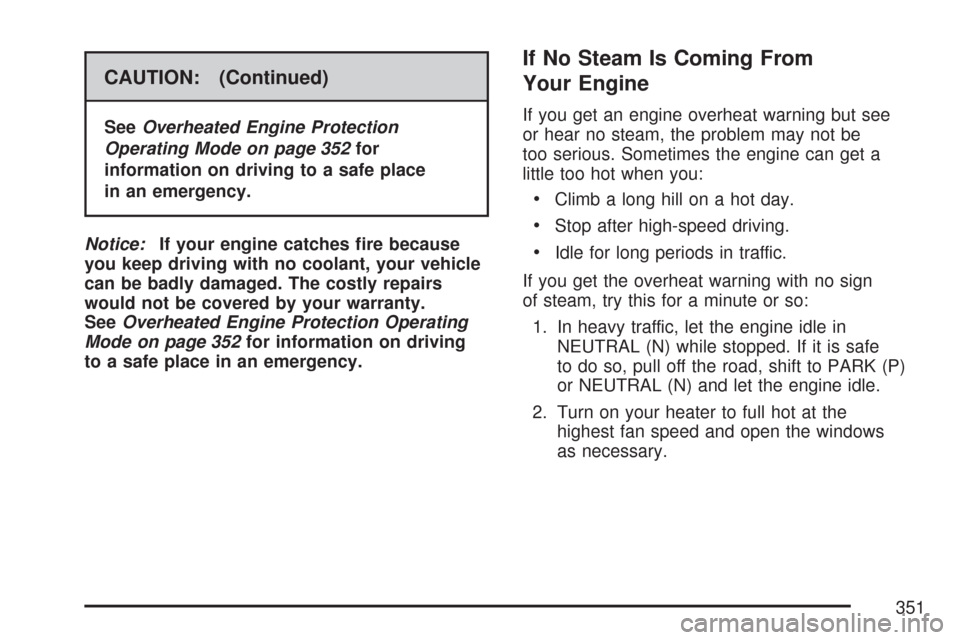
CAUTION: (Continued)
SeeOverheated Engine Protection
Operating Mode on page 352for
information on driving to a safe place
in an emergency.
Notice:If your engine catches �re because
you keep driving with no coolant, your vehicle
can be badly damaged. The costly repairs
would not be covered by your warranty.
SeeOverheated Engine Protection Operating
Mode on page 352for information on driving
to a safe place in an emergency.
If No Steam Is Coming From
Your Engine
If you get an engine overheat warning but see
or hear no steam, the problem may not be
too serious. Sometimes the engine can get a
little too hot when you:
Climb a long hill on a hot day.
Stop after high-speed driving.
Idle for long periods in traffic.
If you get the overheat warning with no sign
of steam, try this for a minute or so:
1. In heavy traffic, let the engine idle in
NEUTRAL (N) while stopped. If it is safe
to do so, pull off the road, shift to PARK (P)
or NEUTRAL (N) and let the engine idle.
2. Turn on your heater to full hot at the
highest fan speed and open the windows
as necessary.
351
Page 354 of 488
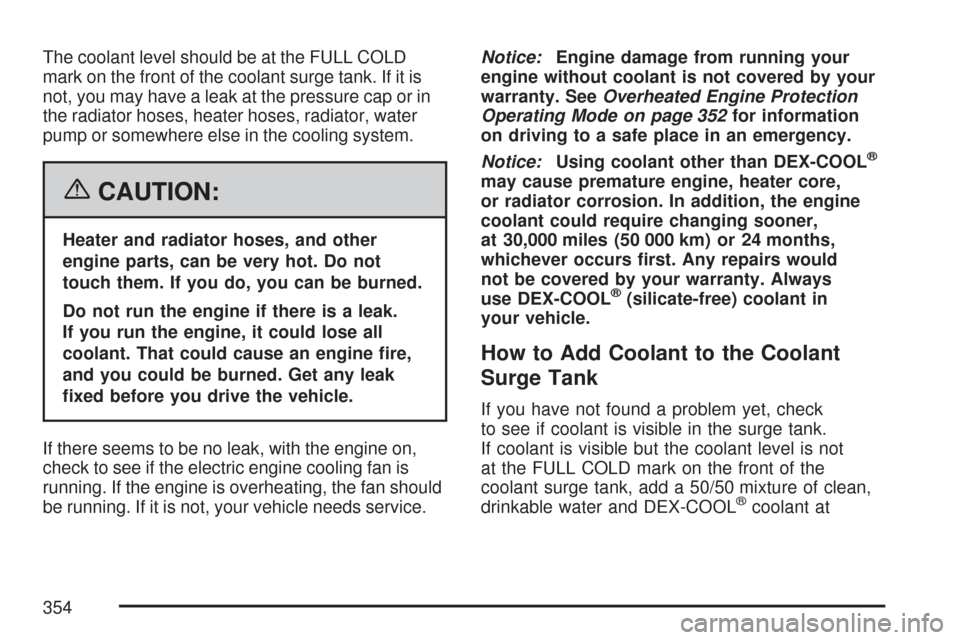
The coolant level should be at the FULL COLD
mark on the front of the coolant surge tank. If it is
not, you may have a leak at the pressure cap or in
the radiator hoses, heater hoses, radiator, water
pump or somewhere else in the cooling system.
{CAUTION:
Heater and radiator hoses, and other
engine parts, can be very hot. Do not
touch them. If you do, you can be burned.
Do not run the engine if there is a leak.
If you run the engine, it could lose all
coolant. That could cause an engine �re,
and you could be burned. Get any leak
�xed before you drive the vehicle.
If there seems to be no leak, with the engine on,
check to see if the electric engine cooling fan is
running. If the engine is overheating, the fan should
be running. If it is not, your vehicle needs service.Notice:Engine damage from running your
engine without coolant is not covered by your
warranty. SeeOverheated Engine Protection
Operating Mode on page 352for information
on driving to a safe place in an emergency.
Notice:Using coolant other than DEX-COOL
®
may cause premature engine, heater core,
or radiator corrosion. In addition, the engine
coolant could require changing sooner,
at 30,000 miles (50 000 km) or 24 months,
whichever occurs �rst. Any repairs would
not be covered by your warranty. Always
use DEX-COOL
®(silicate-free) coolant in
your vehicle.
How to Add Coolant to the Coolant
Surge Tank
If you have not found a problem yet, check
to see if coolant is visible in the surge tank.
If coolant is visible but the coolant level is not
at the FULL COLD mark on the front of the
coolant surge tank, add a 50/50 mixture of clean,
drinkable water and DEX-COOL
®coolant at
354